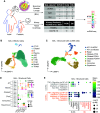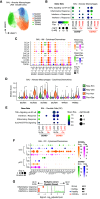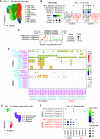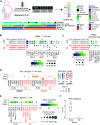Obesity Is Associated with Attenuated Tissue Immunity in COVID-19
- PMID: 36095143
- PMCID: PMC10870921
- DOI: 10.1164/rccm.202204-0751OC
Obesity Is Associated with Attenuated Tissue Immunity in COVID-19
Abstract
Rationale: Obesity affects 40% of U.S. adults, is associated with a proinflammatory state, and presents a significant risk factor for the development of severe coronavirus disease (COVID-19). To date, there is limited information on how obesity might affect immune cell responses in severe acute respiratory syndrome coronavirus 2 (SARS-CoV-2) infection. Objectives: To determine the impact of obesity on respiratory tract immunity in COVID-19 across the human lifespan. Methods: We analyzed single-cell transcriptomes from BAL in three ventilated adult cohorts with (n = 24) or without (n = 9) COVID-19 from nasal immune cells in children with (n = 14) or without (n = 19) COVID-19, and from peripheral blood mononuclear cells in an independent adult COVID-19 cohort (n = 42), comparing obese and nonobese subjects. Measurements and Main Results: Surprisingly, we found that obese adult subjects had attenuated lung immune or inflammatory responses in SARS-CoV-2 infection, with decreased expression of IFN-α, IFN-γ, and TNF-α (tumor necrosis factor α) response gene signatures in almost all lung epithelial and immune cell subsets, and lower expression of IFNG and TNF in specific lung immune cells. Peripheral blood immune cells in an independent adult cohort showed a similar but less marked reduction in type-I IFN and IFNγ response genes, as well as decreased serum IFNα, in obese patients with SARS-CoV-2. Nasal immune cells from obese children with COVID-19 also showed reduced enrichment of IFN-α and IFN-γ response genes. Conclusions: These findings show blunted tissue immune responses in obese patients with COVID-19, with implications for treatment stratification, supporting the specific application of inhaled recombinant type-I IFNs in this vulnerable subset.
Keywords: COVID-19; bronchoalveolar lavage; obesity; single-cell RNA sequencing; type-I interferon.
Figures




Comment in
-
Obesity and COVID-19 Disease: To Inflame or Not.Am J Respir Crit Care Med. 2023 Mar 1;207(5):503-504. doi: 10.1164/rccm.202209-1797ED. Am J Respir Crit Care Med. 2023. PMID: 36170639 Free PMC article. No abstract available.
References
Publication types
MeSH terms
Substances
Grants and funding
LinkOut - more resources
Full Text Sources
Medical
Miscellaneous

